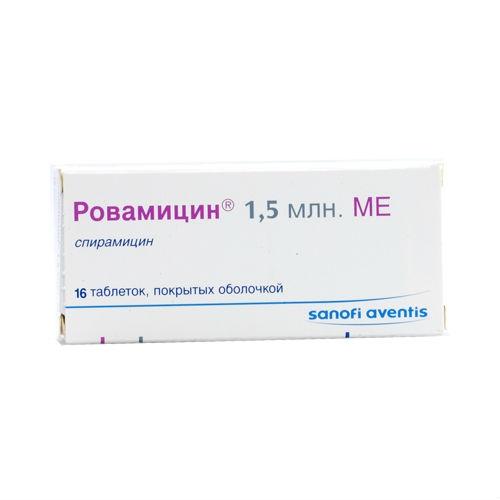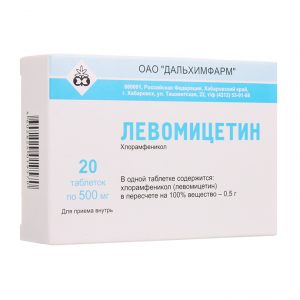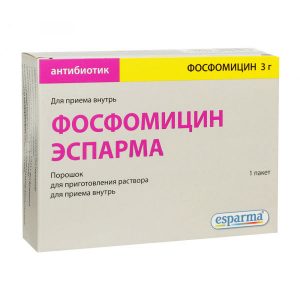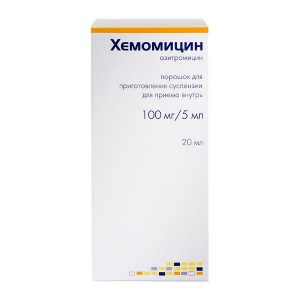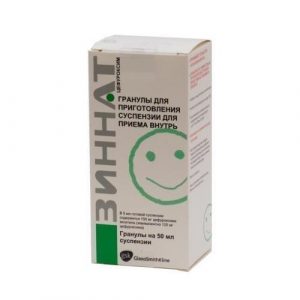Description
Release form
Film-coated tablets.
packaging 16 pcs
Indications
Infectious and inflammatory diseases caused by susceptible microorganisms:
– acute and chronic pharyngitis, caused by beta-hemolytic streptococcus A (as an alternative to treatment with beta-lactam antibiotics, especially in case of contraindications to their use)
– acute sinusitis (given the sensitivity of the microorganisms most often causing this pathology, the use of Rovamycin ® is indicated in case of contraindications to the use of beta- lactam antibiotics)
– acute and chronic tonsillitis caused by spiramycin-sensitive microorganisms
– acute bronchitis caused by a bacterial infection, vsheysya after acute viral bronchitis
– exacerbation of chronic bronchitis
– community-acquired pneumonia in patients with no risk factors for adverse outcome, severe clinical symptoms and the clinical signs of pneumonia, pneumococcal etiology
– pneumonia, caused by atypical pathogens (such as Chlamydia pneumoniae, Chlamydia trachomatis, Mycoplasma pneumoniae, Legionella spp.) or suspected of it (regardless of the severity and presence or absence of risk factors for an adverse outcome)
– infections of the skin and subcutaneous tissue, including impetigo, impetiginization, ectima, infectious dermohypodermatitis (especially erysipelas), secondary infected dermatoses,
erythrasma – infections of the oral cavity (including stomatitis, glossitis)
– non-gonococcal genital infections
– toxoplasmosis, including during pregnancy
– infections of the musculoskeletal system and connective tissue, including periodontium.
Prevention of recurrence of rheumatism in patients allergic to beta-lactam antibiotics.
Eradication of Neisseria meningitidis from the nasopharynx (with contraindications to rifampicin) for the prevention (but not treatment) of meningococcal meningitis:
– in patients after treatment and before quitting
– in patients who were within 10 days before hospitalization in contact with individuals that secrete Neisseria meningitidis with saliva into the environment.
Contraindications
– lactation period
– glucose-6-phosphate dehydrogenase deficiency (risk of acute hemolysis)
– children (for tablets 1.5 million IU – up to 6 years old, for tablets 3 million IU – up to 18 years old)
– hypersensitivity to the components of the drug.
Rovamycinum is prescribed with caution in case of obstruction of the bile ducts, in case of liver failure.
Use during pregnancy and lactation
Rovamycin can be prescribed during pregnancy as indicated.
There is extensive experience with the use of the drug Rovamycin ® during pregnancy. A decrease in the risk of transmitting toxoplasmosis to the fetus during pregnancy is noted from 25% to 8% when using the drug in the first trimester, from 54% to 19% in the second trimester and from 65% to 44% in the third trimester. Teratogenic or fetotoxic effects were not observed.
When prescribing Rovamycin ® during lactation, breast-feeding should be discontinued, as spiramycin may enter breast milk.
Special instructions
During treatment with the drug in patients with liver diseases, it is necessary to periodically monitor its function.
If at the beginning of treatment generalized erythema and pustules occur, accompanied by high body temperature, acute generalized exanthematous pustulosis should be assumed, if such a reaction occurs, then treatment should be stopped, and then the use of spiramycin, as with monotherapy, and in combination, is contraindicated.
Pediatric use
Tablets of 3 million ME in children are not used because of the difficulty of swallowing by children because of the large diameter of the tablets and the risk of airway obstruction.
Influence on the ability to drive vehicles and control mechanisms
There is no information about the negative effect of the drug on the ability to drive a car and engage in other potentially dangerous activities. However, the severity of the patient’s condition, which may affect the attention and speed of psychomotor reactions, should be taken into account. Therefore, the decision on the possibility of driving or engaging in other potentially dangerous activities in a particular patient should be made by the attending physician.
Composition
Spiramycin 1.5 million IU
Excipients: colloidal silicon dioxide – 1.2 mg, magnesium stearate – 4 mg, pregelatinized corn starch – 16 mg, hyprolose – 8 mg, croscarmellose sodium – 8 mg, microcrystalline cellulose – up to 400 mg.
Shell composition: titanium dioxide (E171) – 1.694 mg, macrogol 6000 – 1.694 mg, hypromellose – 5.084 mg.
Dosage and administration of
The drug is taken orally.
Adults appoint 2-3 tablets. 3 million IU or 4-6 tab. 1.5 million each IU (i.e. 6-9 million IU) per day. The daily dose is divided into 2 or 3 doses. The maximum daily dose is 9 million IU.
In children and adolescents aged 6 to 18, only tablets of 1.5 million ME should be used.
In children over 6 years old, the daily dose is from 150-300 thousand ME per kg of body weight, which is divided into 2 or 3 doses up to 6-9 million ME. The maximum daily dose in children is 300 thousand ME per kg of body weight, but with a child weighing more than 30 kg it should not exceed 9 million ME
For the prevention of meningococcal meningitis, adults are prescribed 3 million IU 2 times / day for 5 days, for children – 75 thousand IU / kg of body weight 2 times / day for 5 days.
Dose adjustment is not required in patients with impaired renal function due to minor renal excretion of spiramycin.
tablets are taken orally, drinking plenty of water.
Side effects
The following classification is used to indicate the frequency of occurrence of adverse reactions: very often (? 10%), often (? 1%,
From the digestive system: nausea, vomiting, diarrhea is very rare – pseudomembranous colitis (
from the liver and biliary tract: very rarely (
from the nervous system: very rarely (isolated cases) – transient paresthesia.
from the hematopoietic system: very rarely (
from the cardiovascular system : very rarely – prolongation of the QT interval on the ECG.
On the part of the immune system: skin rash, urticaria, skin itching very rarely (
On the part of the skin and subcutaneous tissue: very rarely – acute generalized exanthematous pustulosis.
Drug interaction
Inhibition of carbidopa absorption with spiramycin with a decrease in plasma levodopa concentration. With the simultaneous administration of spiramycin, clinical monitoring and dose adjustment of levodopa is necessary.
Numerous cases of increased activity of indirect anticoagulants have been reported in patients taking antibiotics. The type of infection or the severity of the inflammatory reaction, the age and general condition of the patient are predisposing risk factors. Under such circumstances, it is difficult to determine to what extent the infection itself or its treatment plays a role in changing the MHO. However, with the use of certain groups of antibiotics, this effect is observed more often, in particular with the use of fluoroquinolones, macrolides, cyclins, a combination of sulfamethoxazole + trimethoprim, and some cephalosporins.
Overdose
No known cases of spiramycin overdose.
Symptoms: possible – nausea, vomiting, diarrhea. Cases of QT prolongation during drug withdrawal, were observed in neonates receiving high doses of spiramycin or after / in the administration of spiramycin in patients predisposed to QT prolongation.
Treatment: ECG monitoring with determination of the duration of the QT interval is recommended for spiramycin overdose, especially in the presence of risk factors (hypokalemia, congenital QT prolongation, concomitant use of drugs that prolong the QT interval and cause gastric ulcer). There is no specific antidote. If spiramycin is overdosed, symptomatic therapy is recommended.
Storage Conditions
The product should be stored out of the reach of children at a temperature not exceeding 25 ° C.
Shelf life
3 years.
Deystvuyushtee substance
Spiramycin
Terms and conditions
prescription
Dosage form
tablets
Appointment
Appointment
Adults doctor’s prescription
Sanofi-Aventis, France
